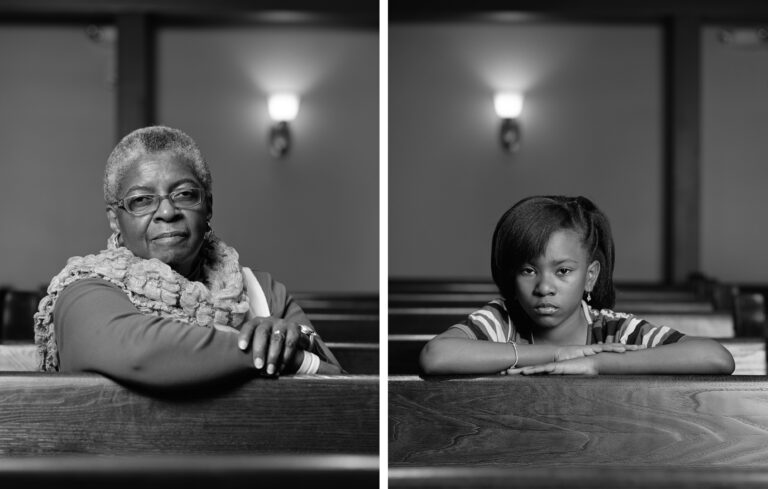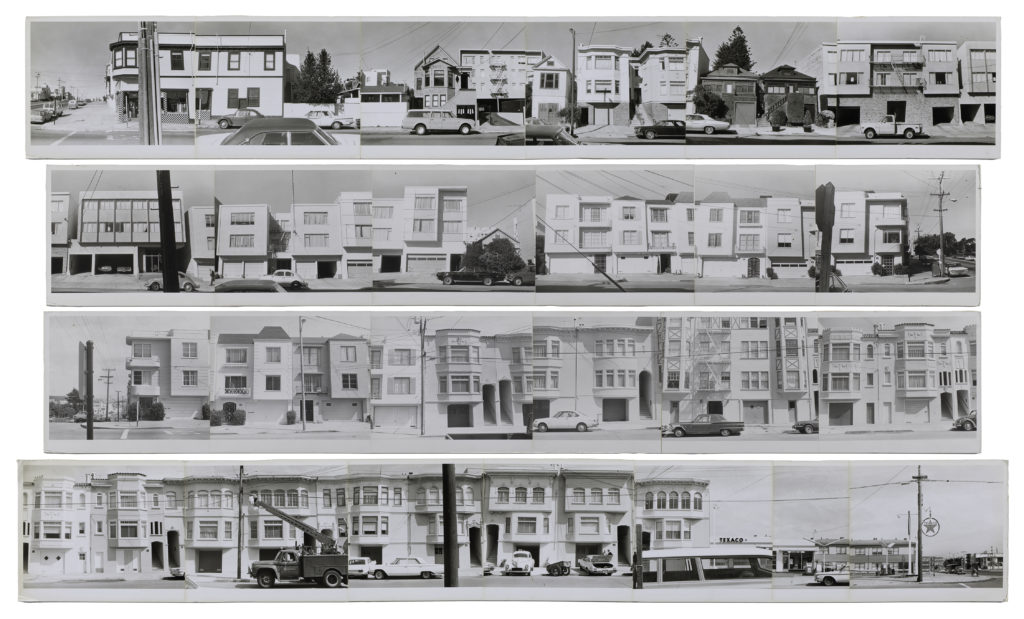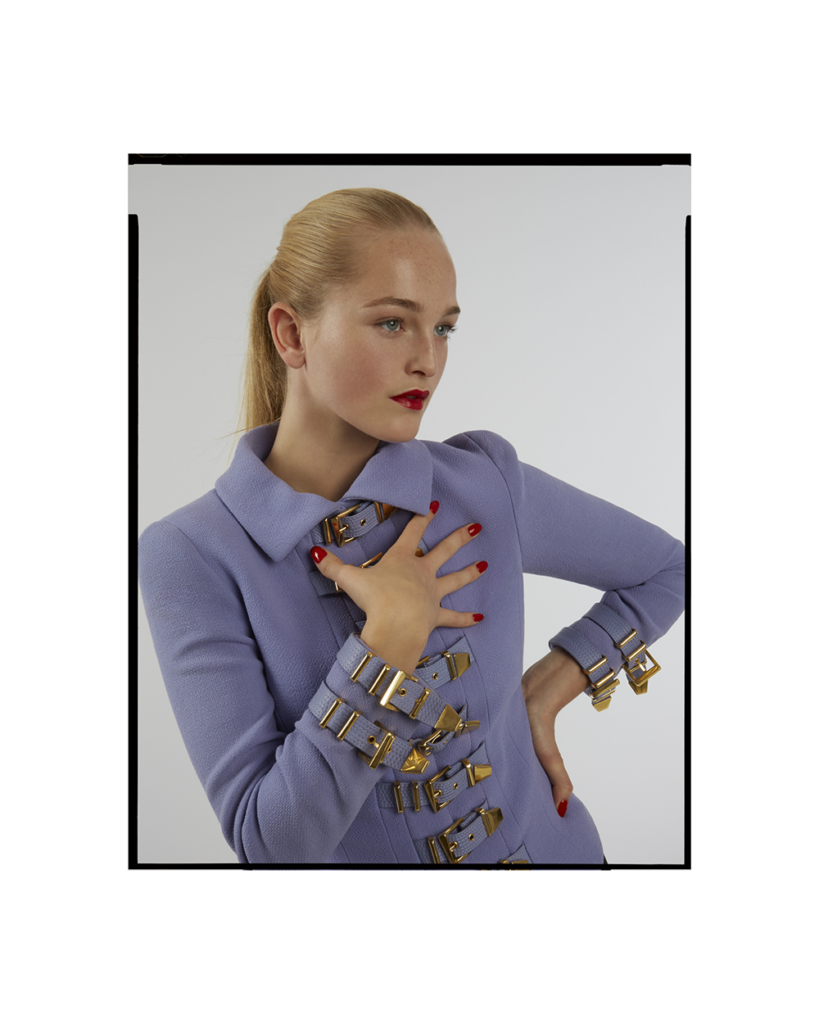
Dawoud Bey, Mary Parker and Caela Cowan, Birmingham, AL, from the series The Birmingham Project, 2012; Rennie Collection, Vancouver; © Dawoud Bey
SAN FRANCISCO, CA (December 4, 2019; updated September 30, 2020) — The San Francisco Museum of Modern Art (SFMOMA) presents an exciting array of photography exhibitions in its Pritzker Center for Photography this winter and spring. Dawoud Bey: An American Project, the influential photographer’s first major retrospective in 25 years, will be on view from February 15 to October 12, 2020. The month prior, two exceptional photography exhibitions will open on January 4: Thought Pieces: 1970s Photographs by Lew Thomas, Donna-Lee Phillips, and Hal Fischer, which explores an intensely active period from the mid to late 1970s for this group of Bay Area–based photographers; and Elad Lassry, which includes three distinct groupings of new work by the Los Angeles–based Israeli artist that analyze the relationship between objects and their representations.
Dawoud Bey: An American Project
February 15–October 12, 2020
Floor 3
Bey has dedicated more than four decades to portraying underrepresented communities and histories. From portraits in Harlem to nocturnal landscapes, classic street photography to large-scale studio portraits, his works combine an ethical imperative with an unparalleled mastery of his medium.
Featuring approximately 80 works, the exhibition, co-organized with the Whitney Museum of American Art, New York, spans the breadth of Bey’s career, from the 1970s to the present. Organized both thematically and chronologically, it ranges from his earliest street portraits in Harlem (1975–78) to his most recent exploration of the Underground Railroad (2017).
“The power of Bey’s work comes from the marriage of his extraordinary formal skill as a photographer with his deeply held belief in the political power of representation,” said Corey Keller, curator of photography at SFMOMA. “He sees making art as not just a personal expression but as an act of social responsibility, emphasizing the necessary work of artists and art institutions to break down obstacles to access, to convene communities and open dialogue. It has been truly inspiring to work with him on this project.”
Describing his process, Bey has said, “It begins with the subject, a deep interest in wanting to describe the black subject in a way that’s as complex as the experiences of anyone else. It’s meant to kind of reshape the world, one person at a time.”
Bey received his first camera as a gift from his godmother in 1968. The following year, he saw the landmark — and highly divisive — exhibition Harlem on My Mind at The Metropolitan Museum of Art in New York. The exhibition, widely criticized for its failure to include significant numbers of artworks by African Americans, nonetheless made an impression on young Bey and inspired him to take up his own documentary project about Harlem in 1975. Since that time, Bey has worked primarily in portraiture, making tender, psychologically rich and direct portrayals of black subjects and rendering African-American history in a form that is poetic, poignant and immediate.
Keller and co-curator Elisabeth Sherman, assistant curator at the Whitney, explain that the exhibition’s title, Dawoud Bey: An American Project, “intentionally inserts Bey’s photographs into a long-running conversation about what it means to represent America with a camera. There is a rich tradition of ‘American’ projects, including Walker Evans’s American Photographs (1938), Robert Frank’s The Americans (1958), Lee Friedlander’s The American Monument (1976) and Joel Sternfeld’s American Prospects (1987).” They continue to ask, “But what truly constitutes an American photograph, and who is considered an American photographer? The question of what it means to be an American photographer, or simply an American, is a particularly poignant one now. Bey evokes the distinctly American experiences of the people and histories he shares through photography. Bey also evokes his own distinctly American experience. Through his thoughtful compositions and arresting pictures, he demands our attention, and reminds us that the past is ever present.”
The exhibition includes work from eight major series and is organized to reflect the development of Bey’s vision over the course of his career, as well as his prolonged engagement with certain themes over time.
The Street
A landmark black-and-white series created from 1975–78, Harlem, U.S.A. documents portraits and street scenes with locals of this historic neighborhood. As a young man growing up in Queens, Bey was intrigued by his family’s history in Harlem — his parents met in church there and it was home to many family and friends he visited throughout childhood. Bey describes the experience of creating Harlem, U.S.A. as a sort of homecoming. This series premiered at the Studio Museum in Harlem in 1979 when the artist was just 26. The exhibition also includes a powerful series of street photographs Bey made in Syracuse, NY, demonstrating not only his keen eye for portraiture and the spontaneous choreography in the streets, but also his sensitivity to his subjects’ environment.
In the 1980s, Bey moved from the easily portable 35mm camera he used to photograph Harlem, U.S.A., to a heavier, more conspicuous, large format (4 x 5”) camera and Polaroid Type 55 film to create a series of more formal “street portraits” in areas such as Brooklyn, NY and Washington, DC. With new equipment and a new approach, Bey began to engage his subjects more deliberately, creating work that elicits an intimate exchange between photographer and subject and, by extension, with the viewer.
The series Harlem Redux marks Bey’s return to photograph the Harlem community from 2014–2017, almost 40 years after his original series. Unlike the black-and-white pictures of Harlem, U.S.A., the new series comprises large-format color landscapes and streetscapes that mourn the transformation of the celebrated African-American community as it becomes more gentrified and its original residents are increasingly displaced.
The Studio
From the street Bey moved into the studio, using a massive 20 x 24” Polaroid camera to make a series of sensitive and direct color portraits first of friends, then later of teenagers he met through a residency at the Addison Gallery of American Art in Andover, MA. At this time, Bey also began experimenting with beautifully lit and framed multi-panel Polaroid portraits, inspired in part by an interest in challenging the singularity of the photographic print.
Bey’s work at the Addison Gallery led to another residency at the University of Chicago’s Smart Museum. There, he began a series he would call Class Pictures, creating striking, large-scale color portraits of high school students accompanied by text that he invited his subjects to contribute. Seeing this kind of collaboration and community building as a key part of his practice, Bey views the conversational and attitudinal shifts that result from this process of exchange as integral to the work as the final objects themselves. Bey continued Class Pictures with high schools across the United States between 2003 and 2006. Focusing on teenagers from a wide range of economic, social and ethnic backgrounds, he created a diverse group of portraits that challenges teenage stereotypes.
History
Two of Bey’s more recent projects explore aspects of African-American history in a form at once expressive and immediate. The Birmingham Project, created in 2012 as a commission from the Birmingham Museum of Art, memorializes the victims of the 1963 bombing of the 16th Street Baptist Church in Birmingham, AL, and its violent aftermath. Expressive portraits of girls and boys the ages of the victims of the bombing and the racial violence that followed are paired with photographs of adults the ages those children would have been in 2012 had they lived. As Keller and Sherman write in their introduction to the exhibition catalogue, “Each diptych represents what was lost and what could have been, charging sitter and viewer alike with the heavy burden of bearing witness.” Half of this series was made in Birmingham’s Bethel Baptist Church, which served as the original headquarters for the Alabama Christian Movement for Human Rights during the civil rights movement. The other half was made in the Birmingham Museum of Art, which commissioned the project as part of a citywide effort to commemorate the lives lost on September 15, 1963.
Along with the portraits, Bey created a single-channel video shot in locations throughout Birmingham, entitled 9.15.63 (2012), which presents another perspective on the day of the 1963 church bombing. Like the photographic series, the video employs the diptych format. Keller and Sherman describe the video as “using a split screen to underscore similarities and disjunctions between two images: one side shows the view out the window of a car moving through the city, panning across treetops and an impossibly blue sky; the other shows seemingly ordinary objects and locations — lunch counters, barbershops, classrooms — from which African Americans drew sustenance and from where the civil rights movement took root.” The video concludes at the 16th Street Baptist Church. Together, these projects honor lives lost, and confront continued national issues of racism and violence against African Americans.
In 2017, Bey completed Night Coming Tenderly, Black, a series of beautifully rendered and evocative images made in Ohio where the Underground Railroad once operated. As landscapes, these large black-and-white photographs mark a formal departure from the artist’s previous work, though they pose many of the same existential questions. Shot by day but printed as if they were taken at night, in deep shades of black and gray, they explore blackness as color—inspired in part by the photographs of Roy DeCarava—and as race. Named for the final refrain of Langston Hughes’s poem “Dream Variations,” and originally installed at St. John’s Episcopal Church, Cleveland, thought to be a key stop on the Underground Railroad, the series conjures the spatial and sensory experience of a slave’s escape to liberation as imagined by the artist.
About Dawoud Bey
Dawoud Bey was born in New York City in 1953 and began his career as a photographer in 1975 with a series of photographs, Harlem, U.S.A., that were later exhibited in his first solo exhibition at the Studio Museum in Harlem in 1979. Since then his work has been featured in exhibitions at numerous institutions worldwide including the Addison Gallery of American Art, Andover, MA; the Art Institute of Chicago; the Brooklyn Museum; the Detroit Institute of Arts; the Fogg Museum, Harvard University; the High Museum of Art, Atlanta; the Museum of Contemporary Art, Chicago; the Museum of Contemporary Photography, Chicago; the National Gallery of Art, Washington, DC; and the Walker Art Center, Minneapolis, among many others.
Bey’s photographs are represented in collections around the globe, and his critical writings on photography have appeared in numerous publications and exhibition catalogues. The recipient of fellowships from the Guggenheim Foundation and the National Endowment for the Arts, Bey received the prestigious MacArthur Foundation “Genius” fellowship in 2017. He holds a Master of Fine Arts degree from Yale University, and is currently Professor of Art and a former Distinguished College Artist at Columbia College Chicago, where he has taught since 1998.
Related Program
CONVERSATION
Dawoud Bey in Conversation with Leigh Raiford
Thursday, February 13, 6 p.m.
Phyllis Wattis Theater
On the occasion of Dawoud Bey’s major retrospective Dawoud Bey: An American Project (opening February 15), the artist joins us for a conversation with Leigh Raiford, chair of UC Berkeley’s African American Studies program. Moderated by exhibition curator Corey Keller, Bey and Raiford’s conversation will expand on the representation of blackness as an aesthetic and political act, and the role that photography plays in visualizing history. Free with RSVP. No museum admission required. For more details, see sfmoma.org.
Exhibition Venues and Dates
SFMOMA: February 15 to October 12, 2020
High Museum of Art, Atlanta: November 7, 2020 to March 14, 2021
The Whitney Museum of American Art, New York: Opens April 17, 2021
Exhibition Organization
Dawoud Bey: An American Project is co-organized by the San Francisco Museum of Modern Art and the Whitney Museum of American Art, New York. It is curated by Corey Keller, curator of photography at SFMOMA, and Elisabeth Sherman, assistant curator at the Whitney Museum of American Art, New York.
Exhibition Support
Major support for Dawoud Bey: An American Project is provided by The Andy Warhol Foundation for the Visual Arts, Randi and Bob Fisher, and The Bernard Osher Foundation. Generous support is provided by the Phillip and Edith Leonian Foundation, The Robert Mapplethorpe Foundation, Nion McEvoy and Leslie Berriman, and Diana and Steve Strandberg. Meaningful support is provided by The Black Dog Private Foundation, Wayee Chu and Ethan Beard, and Sarah Wigglesworth and Asiff Hirji. This project is supported in part by an award from the National Endowment for the Arts.
Catalogue
Dawoud Bey: An American Project is accompanied by Dawoud Bey: Two American Projects, a 128-page catalogue featuring Bey’s two recent historical series — The Birmingham Project and Night Coming Tenderly, Black — both represented in the exhibition. The publication includes approximately 70 illustrations and contributions from Corey Keller; Elisabeth Sherman; artist Torkwase Dyson; Steven Nelson, Professor of African and African American Art and Director of the UCLA African Studies Center; Imani Perry, Hughes-Rogers Professor of African American Studies, Princeton University; Claudia Rankine, award-winning poet, essayist and playwright; and Frederick Iseman, Professor of Poetry, Yale University. The catalogue is edited by Corey Keller and Elisabeth Sherman and is published by the San Francisco Museum of Modern Art in association with Yale University Press, New Haven and London.

Thought Pieces: 1970s Photographs by Lew Thomas, Donna-Lee Phillips, and Hal Fischer
January 4–November 1, 2020
Floor 3
In the early 1970s, Lew Thomas set out to disrupt photography in San Francisco. Tired of the mystical thinking and emotionalism that he felt had dominated work produced in the region since the 1940s, Thomas pursued a practice grounded in Conceptual art and Structuralist philosophy. Donna-Lee Phillips and Hal Fischer were among the cohort of photographers Thomas mentored who embraced Thomas’s mission and followed his lead in questioning long-held orthodoxies and exploring the relationship between photography and language. For a short but intensely active period from the mid to late 1970s, the three frequently exhibited together, wrote about one another’s work and published books under the imprint NFS Press, founded by Thomas and Phillips. This exhibition will reunite their work for the first time since 1981, when Thomas organized the show Photographs and Words for SFMOMA.
Drawn from the museum’s permanent collection and supplemented with loans from the artists and a community of supporters, Thought Pieces will offer an opportunity to reassess the trio’s legacy in the Bay Area and their place in the larger history of photography.
Support
Generous support for Thought Pieces: 1970s Photographs by Lew Thomas, Donna-Lee Phillips, and Hal Fischer is provided by The Black Dog Private Foundation Fund and Randi and Bob Fisher.

Elad Lassry
January 4–March 13, 2020
Floor 3
Elad Lassry probes and disrupts photographic images and prescribed modes of looking to analyze the relationship between objects and their representations. By flattening and compressing the space in and around his photographs and inserting sculptural components, he reorients our connection to images in an uncanny and perplexing way. In this exhibition, Lassry will present three distinct groupings of new work: photographic collages that combine amateur snapshots of nature with archival negatives sourced from sales catalogues; outtakes from an imaginary fashion campaign; and container-like structures made from used motorcycle gas tanks.
Viewed together in the gallery, these photographs and sculptures aim to feel familiar yet disorienting. Lassry’s rigorous conceptual strategies generate intentional collisions, highlighting perceptual paradoxes inherent to the photographic medium, while questioning the very meaning of pictures in contemporary culture.
This exhibition will be in the New to the Collection gallery, a space dedicated to showing recently acquired work or new work by an artist.
Support
Generous support for Elad Lassry is provided by Wes and Kate Mitchell.
Hours and Admission
Open Friday–Monday, 10 a.m.–5 p.m., and Thursday, 1–8 p.m. Closed Tuesday and Wednesday.
Adult general admission to SFMOMA is $25; admission for seniors 65 years and older is $22; and admission for visitors ages 19 through 24 is $19. General admission and special exhibitions are free for all visitors aged 18 and younger.